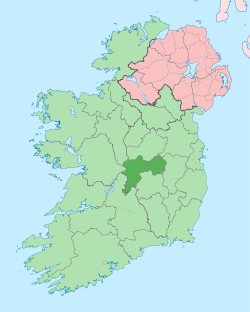Clonmacnoise

The monastery of Clonmacnoise (Cluain Mhic Nóis in Irish, meaning "Meadow of the Sons of Nós", or perhaps, albeit less likely, Cluain Muccu Nóis "Meadow of the Pigs of Nós") is situated in County Offaly, Ireland on the River Shannon south of Athlone.
Clonmacnoise was founded in 544 by St. Ciarán, a young man from Rathcroghan, Co. Roscommon.[1] (Not to be confused or conflated with St. Ciarán of Saigir, patron of Osraige.) Until the 9th century it had close associations with the kings of Connacht. The strategic location of the monastery helped it become a major centre of religion, learning, craftsmanship, and trade by the 9th century and together with Clonard it was the most famous in Ireland, visited by scholars from all over Europe. From the ninth until the eleventh century it was allied with the kings of Meath. Many of the high kings of Tara and Connacht were buried here.
In the modern day, the site stands as a preserved ruin under the management of the Office of Public Works. An interpretive center and facilities for visitors have been built around the site, which is open to the public for a fee. The graveyard surrounding the site continues to be in use and religious services are held regularly on the site in a modern chapel.
History
Shortly after his arrival with seven companions – at the point where the major east-west land route through the bogs of central Ireland along the Eiscir Riada, an esker left by the receding glaciers of the last ice age crossed the River Shannon – Saint Ciarán met Diarmait Uí Cerbaill who helped him build the first church at the site. This was a small wooden structure and the first of many small churches to be clustered on the site. Diarmuid was to be the first Christian crowned High King of Ireland. In September 549, not yet thirty-three years of age, Ciarán died of a plague,[1] and was reportedly buried under the original wooden church, now the site of the 9th century stone oratory, Temple Ciarán.[2]
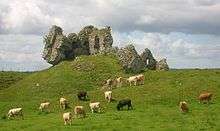
According to Adomnan of Iona, who referenced the testimony of earlier abbots of Iona who had known Columba, St Columba visited the monastery at Clonmacnoise during the time when he was founding the monastery at Durrow. While he was there he prophesied about the future debates in the churches of Ireland about the dating of Easter and claimed that angels had visited the monastery at Clonmacnoise. While he was there, there was a young monk named Ernéne mac Craséni (who would later be famous in Ireland) who tried to touch Columba's clothes while Columba was not looking, but the saint immediately noticed and grabbed the boy by the neck, and then told him to open his mouth and he blessed him, saying that he would teach the doctrine of salvation; the boy was Ernéne mac Craséni, who would later be a great monk in Ireland.[3]
Towards the close of the seventh century a plague carried off a large number of its students and professors.[1] Clonmacnoise's period of greatest growth came between the 8th and 12th centuries. It was attacked frequently during these four centuries, mostly by the English (at least 40 times), the Irish (at least 27 times), the Vikings (at least 7 times) and Normans (at least 6 times).[4] The early wooden buildings began to be replaced by more durable stone structures in the 9th century, and the original population of fewer than ten men grew to perhaps 1,500 to 2,000 by the 11th century. Although the site was based around a core of churches, crosses, graves and ecclesiastical dwellings and workshops, it would have been surrounded by the houses and streets of a larger secular community, the metalworkers, craftsmen and farmers who supported the monastic clergy and their students.[5] Artisans associated with the site created some of the most beautiful and enduring artworks in metal and stone ever seen in Ireland, with the Clonmacnoise Crozier (on display in the National Museum of Ireland) and the Cross of the Scriptures representing the apex of their efforts. The Book of the Dun Cow a vellum manuscript dating to the 12th century, was written here.[6][7]
By the 12th century Clonmacnoise began to decline. The reasons were varied, but without doubt the most debilitating factor was the growth of the town of Athlone to the north of the site from the late-12th century. Athlone became the main trading town for the midlands of Ireland, the most popular route for crossing the Shannon, as well as the best-defended settlement in the region. People migrated north from Clonmacnoise to Athlone, and with the fall in population went much of the support that the site needed to survive, and former allies began to recognise the decline in the site's influence. The influx of continental religious orders such as the Franciscans, Augustinians, Benedictines, Cluniacs, etc. around the same time fed into this decline as numerous competing sites began to crop up. Ireland's move from a monastic framework to a diocesan one in the twelfth century similarly diminished the site's religious standing, as it was designated the seat of a small and impoverished diocese.[8]

In 1552 the English garrison at Athlone destroyed and looted Clonmacnoise for the final time, leaving it in ruins.[9]
The monastery ruins were one of the stops on the itinerary of Pope John Paul II during his visit to Ireland in 1979.[10]
Buildings and High Crosses
The site includes the ruins of a cathedral, seven churches, two round towers, three high crosses and a large collection of Early Christian graveslabs.[11]
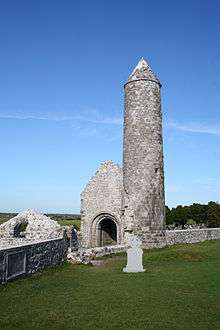
Most of the churches have recently undergone comprehensive conservation works, mostly re-pointing, with the Nun's Church (about 1 km off site), currently under wraps while it too undergoes the same process.
O'Rourke's Tower: Though named O'Rourkes' Tower, after 10th century Connacht king Fergal O'Rourke, the Chronicum Scotorum records that it was finished in 1124 by Turlough O'Connor, king of Connacht, and Gilla Christ Ua Maoileoin, abbot of Clonmacnoise. 11 years later it was struck by lightning which knocked off the head of the tower. The upper part of the tower is later work, so there is some speculation that the masonry thus toppled in the storm of 1135 may have been reused in the building of McCarthy's Tower.[12]
Temple Finghín & McCarthy's Tower: Romanesque church and round tower – 12th century. An unusual occurrence was the vandalism of this church in 1864 by a person from Birr on a 'pleasure party' to the Seven Churches, as Clonmacnoise was often termed. This led to a landmark case when a prosecution was brought against the vandal by the Crown, due to the efforts of the Royal Society of Antiquaries of Ireland. Some of the funds which had been raised for the prosecution were later used by the Society to repair the cap of the church's tower. The structure is possibly the earliest example of a church and round tower being part of a single structure in Ireland.[13]
Temple Connor: Church used by the Church of Ireland since the 18th century.[13] It underwent significant restoration works in the second decade of the twentieth century, when the pitch of the roof was raised and the internal space was remodelled. The church is maintained under the auspices of the Athlone Union of Parishes, and each Sunday during the summer a service is held at four o'clock in the afternoon.
North Cross: Oldest of the three extant crosses. Created c.800. Only the limestone shaft and sandstone base (a former millstone) survive. The decoration is non-Christian, with an image of Cernunnos, the Celtic God of hunting and fertility, displayed on the east face of the shaft.[14][12]
Temple Kelly: All that remains of this church are the low-lying perimeter stones, which still give a good indication of the church's original size.[12]
Temple Ciarán: At 2.8 by 3.8 metres, the smallest church in Clonmacnoise. Traditionally presented as the grave site of St. Ciarán, excavations of the church unearthed the Clonmacnoise Crozier, but no saintly remains.[12]
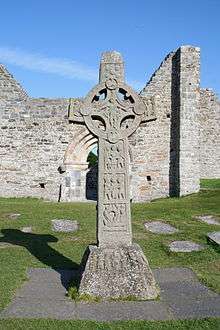
Cross of the Scriptures: This 4-metre high sandstone cross is one of the most skilfully executed of the surviving high crosses in Ireland, and of particular interest for its surviving inscription, which asks a prayer for Flann Sinna, King of Ireland, and Abbot Colmán who commissioned the cross. Both men were also responsible for the building of the Cathedral. The cross was carved from Clare sandstone c.900. The surface of the cross is divided into panels, showing scenes including the Crucifixion, the Last Judgement, and Christ in the Tomb.[15] The original was moved into the visitors' centre in 1991 to preserve it from the elements; a replica stands at the original site.[16]
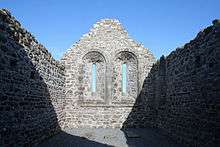
Cathedral (Temple McDermot): Building started around 909 by King Flann Sinna and Abbot Colmán mac Ailella. The west doorway has been recently (and somewhat controversially), comprehensively restored with the Gothic-style north doorway, often called the Whispering Arch, dating to the mid-15th century. The Cathedral is the largest of the churches at Clonmacnoise. Rory O'Connor, the last High King of Ireland, was buried near the altar in 1198, joining his father Turlough. Most of the graves currently seen in the church are those of the Coghlan family, whose patriarch extensively rebuilt the cathedral in the mid-seventeenth century.[17]
Temple Melaghlin: Built c.1200. Also called the King's Church, due to the fact that at least seven generations of Melaghlin Kings are said to be buried underneath the structure.[13] The church is also believed to have housed the scriptorium, the room where the manuscripts were designed and decorated.[18]

South Cross: A 9th-century piece originally situated at the southern end of the site's central hub. It has one Christian scene on its west face, a rough carving of the Crucifixion of Christ. Many believe that the Cross may have been part inspiration for the later Cross of the Scriptures. Again, the original is in the interpretative centre, with a replica occupying its original site.[19]
Temple Dowling: Originally built in the 10th century, this tiny church is named after Edmund Dowling, who renovated it in 1689, placing a stone carving of his family crest above the door.[20]
Temple Hurpan: Built in the 17th century at the east end of Temple Dowling, this annexe had no religious function outside of being a burial ground for some members of the local parish. Sometimes referred to as MacClaffey's Church.[13]
Interpretative Centre and facilities
Clonmacnoise was handed over by the Church of Ireland to the Irish Government in 1955 and has been maintained by various departmental bodies since then. Currently the Office of Public Works manages the site on behalf of the Department of the Environment and Local Government.[9]
The current visitors' centre opened in 1993, replacing a wooden structure, and entry to the site is contingent on the payment of an entry fee seven days a week (from 1973–1985 a part-time guiding/interpretative service was maintained, which also required a small admission fee). The centre was designed to cater for a maximum of 80,000 visitors per annum; it attracted roughly 169,000 visitors in 2007 and 135,000 in 2010.
Main features of the Interpretative Centre are exhibits depicting the history of Clonmacnoise and the area, archaeological artefacts (including the original stone crosses, brought indoors for preservation and display), information on the people who would have lived and worked there, and a section on the local ecology of the Shannon and the wetland bogs. Other amenities include a theatre for audio/visual presentations, a Fáilte Ireland tourist office, gift shop, tea room, toilets and parking. Guided tours of the site may be booked in advance for groups.[21]
The Fairy's or Horseman's Stone
Near the Chapel of Clonfinlough at Clonmacnoise there are several limestone boulders, one of which is called the Fairy's or Horseman's Stone.[22] It has many cup-shaped hollows, crosses, daggers, and a pair of human feet (an example of a Petrosomatoglyph) possibly connected with the inauguration of Gaelic rulers.[23]
The Annals of Clonmacnoise
The Annals of Clonmacnoise chronicle events in Ireland from pre-history to A.D. 1408. The original manuscript or manuscripts are lost, and the names of its compilers are unknown. It is so-called because it was thought to be based on materials gathered at the monastery of Clonmacnoise.[24]
Annalistic references
- 792. Aelmidhair, OEconomus of Cluain Mic Nois, who was of the Sil Maelruanaidh, died.
- 793. Connmhach, son of Burbotha, a descendant of Guaire Aidhne, scribe of Cluain Mic Nois .. died.
- 784. Murghal, Abbot of Cluain Mic Nois, of the race of Fiachra, son of Eochaidh Muighmheadhoin
- 789. Colgu Ua Duineachda, lector of Cluain Mic Nois, he who composed the Scuaip Chrabhaidh, died.
- 793. Connmhach mac Burbotha, a descendant of Guaire Aidhne, scribe of Cluain Mic Nois;
- 794. Anaile, Abbot of Cluain Mic Nois, who was of the Ui Briuin, died.
- 811. Suibne mac Cuanach, Abbot of Cluain Mic Nois, one of the Ui Briuin Seola; Cluain Mic Nois was burned. In thirty days afterwards a victory was gained by Diarmaid, son of Tomaltach, over the Ui Fiachrach Muirisce.
- 814. Duibhinsi, scribe of Cluain Mic Nois;
- 848. Cétadach, Abbot of Cluain Mic Nois, died. He was of the tribe of Ui Cormaic Maenmhaighe. It was in lamentation of him this quatrain was composed: "All have heard it/both uncommon and common/That an abbot at Cluain like Cedadach will never again be seen."
- 899. Ioseph of Loch Con, Abbot of Cluain Mic Nois, of the tribe of the northern Ui Fiachrach;
Clonmacnoise in the Annals of Inisfallen
- AI547. Kl. In this year Cluain Moccu Nóis was founded: that is, Nós, swineherd of the king of Connachta, from whom Cluain Moccu Nóis is named. [AU 549]
- AI548.1 Kl. Death of Mael at the hands of another person named Mael. Repose of Ciarán, son of the wright. Mael Odur [died] the same day.
- AI570.1 Kl. Repose of Aenu, abbot of Cluain Moccu Nóis. [AU 570, 577].
- AI587.1 Kl. Repose of Mac Nise, abbot of Cluain Moccu Nóis. [AU 585, 591].
- AI602.1 Kl. Repose of Ailithir, abbot of Cluain Moccu Nóis. [AU 599].
- AI652.1 Kl. Repose of Aediug, abbot of Cluain, and of Ségéne, abbot of Í. [AU 652].
- AI713.1 Kl. Fáilbe Bec, abbot of Cluain Moccu Nois, rested.
- AI724.1 Kl. Repose of Cuinnles, abbot of Cluain Moccu Nóis.
- AI737.1 Kl. Repose of the grandson of Lóchíne, abbot of Cluain Moccu Nóis.
- AI753.1 Kl. Lucraid, abbot of Cluain Moccu Nóis, [rested].
- AI762.1 Kl. Cormac, abbot of Cluain Moccu Nóis, rested.
- AI771.1 Kl. Forbasach, abbot of Cluain Moccu Nóis, [rested].
- AI784.2 Repose of Rechtabra, abbot of Cluain Moccu Nóis.
- AI789.1 Kl. Murgal, abbot of Cluain Moccu Nóis, fell asleep.
- AI794.3 Ioseph, abbot of Cluain Moccu Nóis, dies.
- AI816.1Bissextile. Kl. The burning of Cluain Moccu Nóis.
- AI850.1 Kl. Repose of Cétadach, abbot of Cluain Moccu Nóis.
- AI868.1 Kl. Connmach, abbot of Cluain Moccu Nóis, dies.
- AI872.2 Ferdomnach, abbot of Cluain Moccu Nóis, [rested].
- AI876.2 Repose of Eógan, abbot of Cluain Moccu Nóis.
- AI886.1 The destruction of Dún Tidill in the territory of Ara.
- AI887.2 Anealoen the pilgrim, came to Ireland, and the wearing of the hair long was abolished by him, and tonsures were accepted.
- 891. Mael Petair mac Cúán, took Cluain Ferta Brénainn.
- 895. Repose of Mael Petair mac Cúán, abbot of Tír dá Glas and Cluain Ferta Brénainn.
- 896. The martyrdom of Mael Achid, abbot of Cluain Moccu Nóis.
- 895. Repose of Fíngen, an anchorite from Mumu, in Cluain Moccu Nóis.
- 904. Repose of Ioseph of Loch Con, abbot of Cluain Moccu Nóis.
- 907. Eight score ferryings(?) [were made] by Cormac, king of Caisel, until they [his forces] arrived in Cluain Moccu Nóis during that Christmas.
- 916. Repose of Aed mac Ailill, abbot of Cluain Ferta Brénainn.
- 922. Tomrair son of Elgi, a Jarl of the foreigners, on Luimnech (the Lower Shannon), and he proceeded and plundered Inis Celtra and Muicinis, and burned Cluain Moccu Nóis; and he went on Loch Rí and plundered all its islands, and he ravaged Mide.
- 926. Kl. Repose of Colmán mac Ailill abbot of Cluain Moccu Nóis and Cluain Iraird.
- 931.Kl. The seventh feria [Saturday], ninth of the moon. Repose of Tipraite mac Amsene, abbot of Cluain Moccu Nóis.
- 934. Kl. Repose of Rebachán mac Mothla, abbot of Tuaim Gréine and king of Dál Cais. Repose of Uallach ingen Muinecháin, poetess of Ireland.
- 951. Kl. A foray by Cellachán and by Donnchadh, and they plundered Cluain Ferta Brénainn and Cluain Moccu Nóis.
- 954. Repose of Dub Inse, learned bishop of Ireland, and of Cellachán, king of Caisel, and of Éladach the learned, abbot of Ros Ailithir, and of Uarach, bishop of Imlech Ibuir, and of Célechair, abbot of Cluain Moccu Nóis and Cluain Iraird, and of Cormac Ua Maíl Shluaig, learned sage of Mumu, and of Lugaid Ua Maíl Shempail, abbot of Domnach Pátraic, and of Cenn Faelad mac Suibne, anchorite of Cluain Ferta Brénainn.
Annals of the Four Masters
- M918.9. A great flood in this year, so that the water reached the Abbot's Fort of Cluain-mic-Nois, and to the causeway of the Monument of the Three Crosses.
- 920.The plundering of Cluain-mic-Nois by the foreigners of Luimneach; and they came upon Loch Ribh, and plundered all its islands.
- 920. The plundering of Cluain-mic-Nois by the son of Ailgi, who afterwards burned it.
- 940. A great flood in this year, so that the lower half of Cluain-mic-Nois was swept away by the water.
- 972. Repose of Tuathal, abbot of Cluain Moccu Nóis.
- 994. Ódhrán Ua hEolais, scribe of Cluain-mic-Nois, died'", and "Irish: & Odhrán ua h-Eolais, scribhnidh Cluana Mic Nóis, d'ég".[25]
- 1002: Flannchad ua Ruaidíne, successor of Ciarán, son of the artificer, of the tribe of Corca-Mogha, died.
- 1007. Robartach the Anchorite, rested in Cluain Moccu Nóis.
Clonmacnois Youth Festival
In 1979, when Pope John Paul II visited the ruins, he famously said that 'the walls of these ruins are charged with a great mission.'[26] Since 2007, Youth 2000 Ireland, a national non-profit Catholic organisation for young people, run a donation only summer festival every year in St Mary's Field, by the ruins of the old monastery. This has grown into a major event, with over a thousand young people attending. It is usually held mid August and it for all youth age 16–35.[26]
See also
- Abbot of Clonmacnoise, for a list of abbots
- Bishop of Clonmacnoise, for a list of bishops
- Priests of Clonmacnoise
- Scribes, Lectors and Wise men of Clonmacnoise
- Anchorites of Clonmacnoise
- Head of the Céili Dé of Clonmacnoise
- Seniors and Wise men of Clonmacnoise
- Head of the little church of Clonmacnoise
- Guestmaster of Clonmacnoise
- Officials and Students of Clonmacnoise
- Clonmacnoise and West Offaly Railway
- Quern (tombstone) – a tombstone from Clonmacnoise
- List of abbeys and priories in Ireland (County Offaly)
- List of towns and villages in Ireland
Notes
- 1 2 3 "CATHOLIC ENCYCLOPEDIA: Abbey and School of Clonmacnoise".
- ↑ Monahan, John (1886). Records Relating to the Dioceses of Ardagh and Clonmacnoise. M.H. Gill and Son. p. 52.
- ↑ Adomnan of Iona. Life of St Columba. ed. Richard Sharpe. 1995, Penguin Books.
- ↑ Ryan, John (1 January 1976). Clonmacnois: a historical summary. Stationery Office [for] the National Parks and Monuments Branch, Office of Public Works. pp. 47–51.
- ↑ Dr.R.J.Quinn. "Clonmacnoise Bridge - AD 804".
- ↑ Tibus, Website design and development by. "Clonmacnoise - Monastic site - Attractions - Churches, Abbeys and Monasteries - All Ireland - Republic of Ireland - Offaly - Clonmacnoise - All Ireland - Republic of Ireland - Offaly - Shannonbridge - Discover Ireland".
- ↑ Graves, James (1864–66). "Proceedings". Journal of the Royal Society of Antiquaries of Ireland. 8: 109–113, 174–9.
- ↑ Flanagan, Marie Therese (2010). The Transformation of the Irish Church in the Twelfth and Thirteenth Centuries. Boydell & Brewer. pp. 172–174. ISBN 978-1-84383-597-4.
- 1 2 Ring, Trudy; Watson, Noelle; Schellinger, Paul (28 October 2013). Northern Europe: International Dictionary of Historic Places. Routledge. p. 180-182. ISBN 978-1-136-63944-9.
- ↑ Harbison, Peter (1 April 1995). Pilgrimage in Ireland: The Monuments and the People. New York: Syracuse University Press. p. 117. ISBN 978-0-8156-0312-2.
- ↑ "Clonmacnoise", Heritage Ireland
- 1 2 3 4 Davenport, Fionn (January 2008). Ireland. Lonely Planet. p. 364. ISBN 978-1-74104-696-0.
- 1 2 3 4 Colvert, Brendon K. (14 August 2014). CLONMACNOIS. Author House. pp. 17–18. ISBN 978-1-4969-8868-3.
- ↑ Archaeologia Cambrensis. W. Pickering. 2003. p. 7.
- ↑ Dunne, Michael; McEvoy, J. J. (January 2002). History and Eschatology in John Scottus Eriugena and His Time: Proceedings of the Tenth International Conference of the Society for the Promotion of Eriugenian Studies, [held At] Maynooth and Dublin, August 16-20, 2002. Leuven University Press. pp. 265–266. ISBN 978-90-5867-241-4.
- ↑ Marsh, Richard; Penn, Elan; McCourt, Frank (28 February 2006). The Legends & Lands of Ireland. Sterling Publishing Company Incorporated. pp. 141–142. ISBN 978-1-4027-3824-1.
- ↑ Fallow, Thomas McCall (1894). The Cathedral Churches of Ireland. Bemrose & Sons. Limited. p. 21.
- ↑ The Heritage of Clonmacnoise. Environmental Sciences Unit, Trinity College in association with County Offaly Vocational Educational Committee. 1987. pp. 30–32. ISBN 978-0-9512627-1-9.
- ↑ Monk, Michael A.; Sheehan, John (1998). Early Medieval Munster: Archaeology, History and Society. Cork University Press. p. 137. ISBN 978-1-85918-107-2.
- ↑ Monahan, John (1886). Records Relating to the Dioceses of Ardagh and Clonmacnoise. M.H. Gill and Son. p. 65.
- ↑ Somerville, Christopher (January 2007). Ireland. National Geographic Society. pp. 253–254. ISBN 978-1-4262-0022-9.
- ↑ The Journal of the Kilkenny and South-east of Ireland Archaeological Society. 8. Ireland Archaeological Society. 1867. p. 360.
- ↑ Williams, Howard; Kirton, Joanne; Gondek, Meggen (2015). Early Medieval Stone Monuments: Materiality, Biography, Landscape. Boydell & Brewer. p. 235. ISBN 978-1-78327-074-3.
- ↑ Kehnel, Annette (1997). Clonmacnois - the Church and Lands of St. Ciar'an: Change and Continuity in an Irish Monastic Foundation (6th to 16th Century). LIT Verlag Münster. pp. 33–40. ISBN 978-3-8258-3442-5.
- ↑ AFM.
- 1 2 "Clonmacnoise youth festival draws the crowds".
References
- Annals of the Four Masters, ed. & tr. John O'Donovan (1856). Annála Rioghachta Éireann. Annals of the Kingdom of Ireland by the Four Masters... with a Translation and Copious Notes. 7 vols (2nd ed.). Dublin: Royal Irish Academy. CELT editions. Full scans at Internet Archive: Vol. 1; Vol. 2; Vol. 3; Vol. 4; Vol. 5; Vol. 6; Indices.
- King, Heather A (1998). Clonmacnoise Studies Vol.1. Duchas & Wordwell. ISBN 0-7076-5098-4.
- King, Heather A (2003). Clonmacnoise Studies Vol.2. Dept of the Environment, Heritage and Local Government & Wordwell. ISBN 0-7557-1793-7.
External links
| Wikivoyage has a travel guide for Clonmacnoise. |
| Wikimedia Commons has media related to Clonmacnoise. |
Coordinates: 53°19′26″N 7°59′28″W / 53.32389°N 7.99111°W
